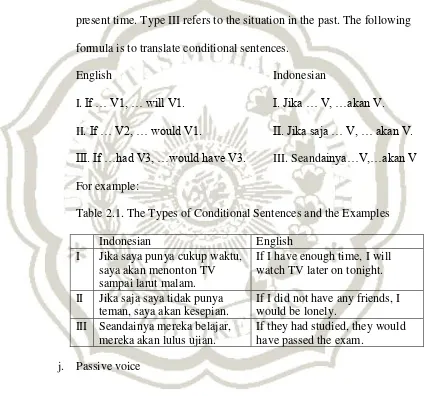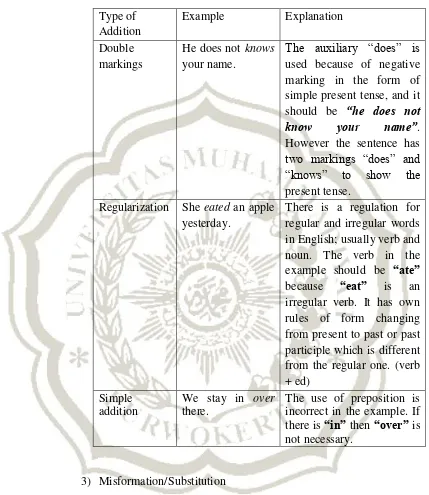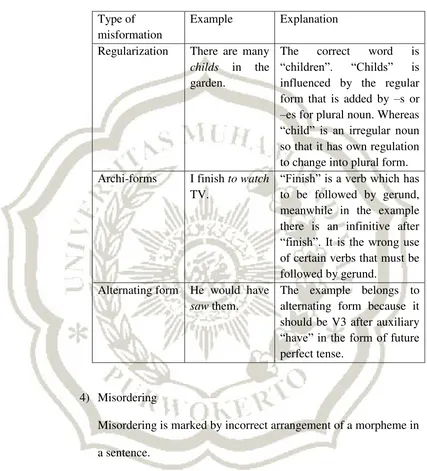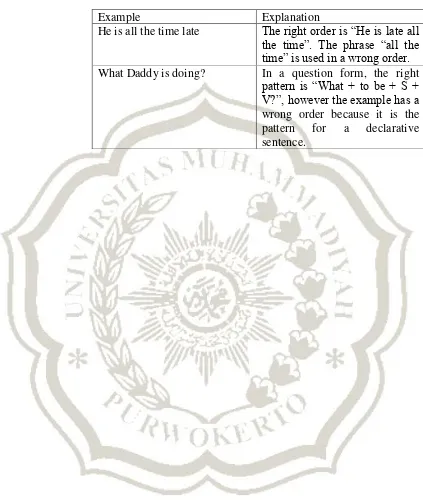CHAPTER 2 LITERATURE REVIEW
A. Previous Research
There were some researches related to analysis on grammatical errors in translation. Those previous researches show that there are some categories of grammatical errors made by the students‟ in translation. The areas of
grammatical errors analyzed are different to a researcher to other.
A research was conducted by Hambali (2011) entitled “Investigating Grammatical Errors in Translation” identified six different types of
grammatical errors made by the students in translation. The types of grammatical errors are as in the following: (1) absence of subject and verb in a clause, (2) subject missing in a clause, (3) verb missing in a clause, (4) subject-verb agreement, (5) absence of subordinators, and (6) absence of plural nouns. The finding indicates that the highest number of students making errors is on using plural nouns and the lowest one is on the absence of subject and verb. Hambali said that errors are affected by students‟ lack of knowledge
of grammar and source language interference. He states that those factors are the major possibilities of causes of grammatical errors in translation.
This research investigated the frequency of grammatical errors related to the four categories. The categories are (1) preposition, (2) relative pronoun, (3) article, and (5) tense. The result of the study showed that the students had the most number of errors in preposition (100%), relative pronoun (56.7%), article (25%), and tense (6.7%). This participant of the research was junior EFL students of Shahid Bahonar University.
B. Translation
1. Definition of Translation
Translation is a process to change a text in a language into another language which has equivalent meaning so that the reader can catch the message from the source language in the form of target language. It is similar with Newmark‟s statement (1988: 5) that translation is rendering
the meaning of a text into another language in the way that the author intended the text. He focuses on the meaning of a text in translating which should have similarity and equivalence in both of the original text and the target one.
original written text or the source text into a written text in the target language. This kind of translation is called „interlingual translation‟.
There are three categories of translation according to Jakobson (2000: 114) in Munday (2001: 5), they are:
a) intralingual translation, this kind of translation occurs when one rephrases a text in the same language to clarify or explain something; b) interlingual translation, is an interpretation of verbal signs by means of
some other language, this happens in translating a text from one language to other language; and
c) intersemiotic translation, this kind of translation would occur if a written text were translated into music, film or painting.
2. Approaches to translating
To consider something, approach has to be carried out, likewise, in translating a text. Newmark (1988: 21) in his book mentions two approaches to translating, they are:
b) read the whole text three or two times, and find the intention, register, tone, mark the difficult words and passages and start translating only when it has taken one‟s bearings.
3. The Methods of Translation
A method is needed in the process of translating to recognize the way how to do translation. Newmark (1988: 45) divides two different emphases in the methods of translation; they are source language emphasis and target language emphasis. The following diagram shows the kinds of translation methods of SL emphasis and TL emphasis in the form of flattened V diagram:
SL emphasis TL emphasis
Word-for-word translation Adaptation
Literal translation Free translation
Faithful translation Idiomatic translation
Semantic translation Communicative translation SL emphasis
1) Word-for-word translation
The main use of word-for-word translation is either to understand the mechanics of the source language or to construe a difficult text as a pre-translation process.
2) Literal translation
The SL grammatical constructions are converted to their nearest TL equivalents but the lexical words are again translated singly, out of context. As a pre-translation process, this indicates the problems to be solved.
3) Faithful translation
A faithful translation attempts to reproduce the precise contextual meaning of the original within the constraints of the TL grammatical structures. It „transfers‟ cultural words and preserves the degree of grammatical and lexical „abnormality‟ (deviation
from SL norms) in the translation. It attempts to be completely faithful to the intentions and the text-realization of the SL writer. 4) Semantic Translation
TL emphasis 1) Adaptation
This is the „freest‟ form of translation. It is used mainly for
plays (comedies) and poetry; the themes, characters, plots are usually preserved, the SL culture converted to the TL culture and the text rewritten.
2) Free translation
Free translation reproduces the matter without the manner, or the content without the form of the original. Usually it is a paraphrase much longer than the original, a so-called „intralingual translation‟.
3) Idiomatic translation
Idiomatic translation reproduces the „message‟ of the
original but tends to distort nuances of meaning by preferring colloquialisms and idioms where these do not exist in the original. 4) Communicative translation
The limitation on the method of translation in this research is only literal and idiomatic translation. It is because literal translation focuses on the grammatical aspect in the SL language to be transferred to the closest TL equivalence. Besides, idiomatic translation makes the meaning of the text more acceptable in the target language with appropriate lexical and grammatical structure. Baker (1992:86) explains that differences in the grammatical structures of the source and target language often result in some change in the information content of the message during the process of translation. Moreover, she states if the TL lacks a grammatical category which exists in the SL or on the contrary, the information expressed by that category may have to be ignored.
4. The Level of Translation
Before starting translating, we should know the level of translation. It will make us easy when we want to translate a text with each certain level. As Newmark (1988: 22) states we translate with four levels more or less consciously in mind. The four levels of translation are:
a. Textual Level
b. Referential Level
This level is the level of objects and events, real or imaginative, where you mentally sort out the text and build up the referential picture in the mind when transforming a text from the SL into the TL.
c. Cohesive Level
This level is general and covers both the structure and the moods of the text. The structure here includes some grammatical aspects in a text such as connective words. Meanwhile the moods are about feeling and emotion in the text.
d. The Level of Naturalness
Translating a text of a language into another language should be done naturally. It means that the translator has to make the text in the target language sound natural grammatically as well as lexically. Because of that, the translator has to ensure:
1) that the translation makes sense;
2) that it reads naturally, that it is written in ordinary language, the common grammar, idioms and words that meet kind of situation (Newmark, 1988:24).
5. The Process of Translation
According to Nida and Taber (1974: 33) there are two different processes for translating. The first is setting up a series of rules which are intended to be applied strictly in order and are designed to specify exactly what should be done with each item or combination of items in the SL so as to select the appropriate corresponding form in the receptor or target language. This process uses an intermediate stage which is based on the application of surface structure of language.
In this research, the process of translation used is the second one which consists of three steps; analysis, transfer and restructuring, as described in the following diagram.
A (source) B (receptor/target)
Analysis Restructuring
X Transfer Y
(Nida and Taber, 1974: 33) Scheme 2.1. Translation Process
a. Analysis step: the surface structure is analyzed the grammatical relationships, the meanings of the words and combinations of words.
c. Restructuring: the transferred material is restructured in order to make the final message fully acceptable in the target language.
6. Evaluation of Translation
To evaluate translation result, first thing that has to be known is what aspects should be assessed and then the second is how to evaluate the translation result.
First of all, the aspects should be evaluated in translation according to Nadar in Alim (2011: 169) are in the following:
a) Accuracy
Accuracy refers to the sameness level of meaning between the source language text as the input and the target language text as the product or output.
b) Clearness
Clearness means that the translation result is easy to be understood and acceptable either grammatically or meaning.
c) Naturalness
Lastly, naturalness refers to the purity of the translation result, and it has to be felt as the original one.
186-189) proposed some ways of evaluating translation result, they are text analysis, the translator‟s purpose, comparing the translation with the original, and the evaluation of translation.
C. Grammatical Error in Translation
Grammatical errors are mistakes made by human that can cause problems in the grammatical structure. Based on Baker‟s statement (1992:86), differences in the grammatical structure of the source and target languages often cause some changes in the information content of the message during the process of translation, for instance, Indonesian and English languages. Indonesian and English languages have different grammatical characteristic. As the consequence, the translator gets problems of grammatical adaptation when he translates English text into Indonesian one or on the contrary (Suryawinata & Sugeng, 2003: 77). Indeed, this will be worst if one of the languages has a grammatical category which another one lacks. For sure, it tends to be a big problem faced by the translator.
1. Translation Problems
(2011: 169) he classifies translation problems into the following categories:
a. Accuracy or equivalence
To achieve the equivalency, a translator has to think about how to choose the appropriate vocabularies, to arrange them in a grammatical sentence that reflects the meaning of the SL text.
b. Ecological terms
Ecological terms related to flora and fauna are sometimes difficult to translate because of geographical difference between those terms in both SL and TL.
c. Technical or material terms
This term includes the translation of the kinds of food, beverages, fashions, transportation, etc.
d. Social terms and custom
Social terms and custom reflects social and political life of a nation such as terms in social organizations, political parties, state bodies, ministry positions, etc. This could be a problem since each nation has different terms to mention those parts.
e. Language problem
From those problems, the problem investigated in this research is language problem that happen the most in translation. This research only concerns in this problem, especially in grammatical structure in both source and target languages. The different grammatical structure in both source and target languages causes many problems and it becomes errors if this occurs some times in the process of translation. Furthermore, the fact that the translator, in this case, the students of English department lack language competence may lead grammatical errors in translation. Sometimes grammar aspect is unintentionally ignored by the students. They are not aware of that aspect, whereas grammar is an important aspect as the goal in the translation.
2. Some Differences on Grammar between Indonesian and English Language
Differences of grammatical rules may cause problems, even in translating a text in another language. Suyawinata & Sugeng (2003:77-85) in their book entitled “Translation” present some grammatical differences
between Indonesian and English languages which have potential to be problems in translation.
a. Article
„nya‟, „itu‟, „ini‟, „tadi‟, and „tersebut‟. While, Indefinite article is such as „a‟ or „an‟ which can be translated into Indonesian as „sebuah‟, „sebutir‟, „seekor‟, „sekuntum‟, „seorang‟, etc. Moreover, an
Indonesian sentence that does not have articles can be translated in English with articles. For example:
Indonesia English
Kendaraanku adalah kuda My vehicle is a horse.
Ayahku mengendarai motor. My father drives a motorcycle.
b. Plural Noun
Plural is not needed to be translated in Indonesian. English has nominal concord and agreement but Indonesian does not. The rule forces a plural noun should be in the form of plural.
For example:
English Indonesian
two books dua buku (not dua buku-buku)
some books beberapa buku ( not beberapa buku-buku) few people beberapa orang ( not beberapa orang-orang)
c. Pronoun
English has some personal pronouns, but it is not as complex as in Indonesian. There is a division based on gender or sex, singular or plural, and inanimate things. For gender we can use she, her, hers, he, him, his, whereas for singular or plural, it, its, they them, their, theirs,
we, our, and ours. We can translate „she‟ or „he‟ as „dia‟ in Indonesian without mentioning the sex. For example:
English Indonesian
She is a student. Dia adalah seorang siswa. (not Dia perempuan adalah seorang siswa)
He is a good doctor.
Dia adalah seorang dokter yang baik. (not Dia laki-laki adalah dokter yang baik)
In addition, the use of „it‟, „its‟ and „they‟ and „them‟ for inanimate
For example:
English Indonesian
In the darkness, the big old house looks so frightening. It stands with no neighbors, alone in the middle of the forest. Its windows locked all time, nobody knows what‟s behind them.
Dalam kegelapan, rumah tua yang besar itu tampak sangat menakutkan. Rumah tersebut terpencil tanpa tetangga, sendirian di tengah hutan itu. Jendela-jendelanya terkunci sepanjang waktu, tanpa seorang pun tahu ada apa di balik (jendela-jendela) itu.
d. Noun Phrase
Noun phrase consists of „article + adjective + noun‟ in English. It is different from Indonesian which consists of „(article) + noun + adjective‟ and it has to be begun by a noun.
For example:
English Indonesian
a patient man (seorang) lelaki yang sabar an intelligent young girl (seorang) gadis muda yang cerdas a tall water tower (sebuah) menara air yang tinggi Meanwhile, there is another arrangement of noun phrase in English. It is different from the rule above that adjective may be after noun. For example:
English Indonesian
Something interesting Sesuatu yang menarik
A girl in red (seorang) gadis berpakaian merah
Rooms available Kamar yang tersedia
A beautiful intelligent young girl in red
e. Gerund
Gerund is the form of Verb 1+ing in English and its function is as a noun. It can be placed as subject, object, after preposition and certain verbs. Because Indonesian does not have gerund, it can be translated into verb or noun which is derived from the gerund. For example:
English Indonesian
You will study the history of whaling and the present critical situation of this magnificent animal.
Anda akan mempelajari sejarah penangkapan ikan paus dan situasi kritis saat ini dari binatang yang hebat tersebut.
Whaling has been done by man for centuries and, in places, provides a main source of food.
Penangkapan ikan paus telah dilakukan manusia selama berabad-abad, dan di beberapa tempat, menjadi sumber pangan utama.
f. Participle
Participle is an adjective derived from verbal phrase. There are two kinds of participle. The first is present participle which is derived from Verb 1 + ing and the second is past participle that is formed by Verb 3. In addition, present participle is translated as an active sentence, while past participle is translated as a passive sentence in Indonesian. For example:
English Indonesian
g. Tenses
English has three basic tenses namely past, present, and future. The verb in tenses is changed by the time when situation happens. However, Indonesian does not have such the tenses. The English sentences in form of tense are translated to be „sudah/telah‟ for the past, „sedang‟ for the present, and „nanti/akan‟ for future.
For example:
English Indonesian
He is writing a very long letter. Don‟t disturb him. He will be here soon. I know it for sure that he has visited his wife last month. He also talked about her yesterday in the café. I could see from his eyes that he always said he would always love her. You know, new couple!
Ia sedang menulis surat yang sangat panjang. Janga ganggu dia. Ia akan ke sini segera. Aku dengan pasti bahwa ia telah mengunjungi mencintainya. Maklum, pengantin baru!
h. Question Tag
Question tag is a question added to at the end of a declarative sentence which is used to engage the listener and verify that something has been understood, or confirm that an action has occurred. It can be translated as „bukan‟, „kan‟, or „ayolah‟ in Indonesian. For example:
English Indonesian
You are not serious, are you? Anda tidak serius, bukan?
i. Conditional Sentence
There are three types of conditional sentences. Conditional type 1 refers to the future. An action in the future will only happen if a certain condition is fulfilled by that time. Type II refers to the situations in the present time. Type III refers to the situation in the past. The following formula is to translate conditional sentences.
English Indonesian
I. If … V1, … will V1. I. Jika … V, …akan V. II. If … V2, … would V1. II. Jika saja … V, … akan V. III. If …had V3, …would have V3. III. Seandainya…V,…akan V For example:
Table 2.1. The Types of Conditional Sentences and the Examples
Indonesian English
I Jika saya punya cukup waktu, saya akan menonton TV sampai larut malam.
If I have enough time, I will watch TV later on tonight. II Jika saja saya tidak punya
teman, saya akan kesepian.
If I did not have any friends, I would be lonely.
III Seandainya mereka belajar, mereka akan lulus ujian.
If they had studied, they would have passed the exam.
j. Passive voice
other words, the object of an active verb becomes the subject of the passive verb. The passive voice is used in English when it is more convenient or interesting to stress the thing done or when the doer is unknown. In a passive sentence the agent, or doer of the action, is rarely mentioned. When the agent is mentioned it is preceded by “by” (Thomson and Martinet, 1980: 254-255).
For example;
Indonesian English
Jam tanganku telah dicuri. My watch was stolen. She eats an apple. An apple is eaten (by her).
Beside the above grammatical differences, other categories of grammatical differences between Indonesian and English language that can be errors in translation are from Hambali. These categories are based on the findings of his research entitled “Investigating Grammatical Errors in Translating”. The categories are (Hambali, 2011:4):
a. Subject and verb missing in a clause
English Indonesia
That house is expensive. Rumah itu mahal. The floating house is a
traditional house.
Rumah terapung adalah rumah adat. The kites are above the raft. Layang-layang itu di atas rumah
rakit.
The words „expensive‟ and „mahal‟ are adjectives. Adjectives need words „is‟ and „are‟ in the sentences above as verbs (linking verbs). Meanwhile, in the sentences “Rumah itu mahal”, “Rumah terapung
adalah rumat adat.”, and “Layang-layang itu di atas rumah rakit.”, they do not require verbs.
b. Subject-verb agreement
Indonesian so that this grammatical difference leads problems in translating Indonesian text into English one.
For example:
Indonesian English
Rumah terapung masih ada dan menjadi salah satu rumah
tradisional Palembang.
Floating house still exists and becomes one of Palembang
traditional houses.
D. Error Analysis 1. Definition
Error is different from mistake. Error exists when the learners do not master target language very well. They have lack of knowledge and competence of the target language.
The explanation previously mentioned is supported by Tarigan‟s
statement (1995: 75) that error can happen because the learners do not yet understand linguistic system of target language. He adds that error always occurs consistently and continuously if it is ignored by the teacher. That‟s why an error analysis should be taken in order to fix learners‟ errors.
Error Analysis is procedures for collecting sample of error, identifying, explaining, classifying and evaluating errors done by a researcher or a language teacher (Tarigan, 1995:68).
In summary, error analysis is a set of procedures for collecting sample of error, identifying, explaining, and evaluating learners‟ errors.
2. Procedures of Error Analysis
To conduct an error analysis, we need to carry out some steps that are included in the process. Tarigan (1995: 71) in his book modifies the steps of error analysis. They are:
a. Collecting sample of learners‟ work
In the first step, data or sample is collected from students‟ work. When collecting the data we have to consider what the purpose of the research so that the data taken are relevant to the research problem. b. Identifying errors
Next step, errors should be identified and classified based on certain category, for example, when identifying grammatical errors in learners‟ texts, they have to be compared to what is grammatically
correct in English grammar books. c. Ranking the errors
After identifying the errors, we have to rank the errors according to the frequency of their occurrence.
d. Explaining the errors
e. Error evaluation
The last step in error analysis is to evaluate errors and draw a conclusion on the results. In this step, the different errors are being weighed in order to distinguish which error should get more attention and be taught in class.
3. Types of Error
Error can happen because one lacks of competence of the language when he is learning one language or more. Error is divided into two types generally according to Tarigan (1995: 85), they are:
a) Intralingual error, this error is caused by the students‟ difficulties in learning the language itself.
b) Interlanguage error, this error occurs because of interference of mother tongue to target language being learned.
Interlanguage error can be divided into some sub-types, they are omission, addition, misinformation, and misordering.
1) Omission
2) Addition
Table 2.2. The Description of Types of Addition and the Examples
Regularization She eated an apple yesterday.
There is a regulation for regular and irregular words in English; usually verb and noun. The verb in the example should be “ate” because “eat” is an irregular verb. It has own rules of form changing from present to past or past participle which is different
Table 2.3. The Description of Types of Misformation and the Examples
Type of misformation
Example Explanation Regularization There are many
childs in the –es for plural noun. Whereas “child” is an irregular noun so that it has own regulation to change into plural form. Archi-forms I finish to watch
TV.
“Finish” is a verb which has to be followed by gerund, meanwhile in the example there is an infinitive after “finish”. It is the wrong use of certain verbs that must be followed by gerund.
Alternating form He would have saw them.
The example belongs to alternating form because it should be V3 after auxiliary “have” in the form of future perfect tense.
4) Misordering
Table 2.4. The Examples of Misordering
Example Explanation
He is all the time late The right order is “He is late all the time”. The phrase “all the time” is used in a wrong order. What Daddy is doing? In a question form, the right



